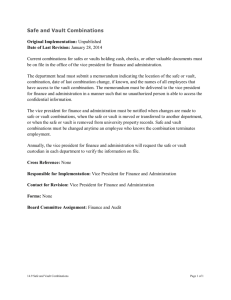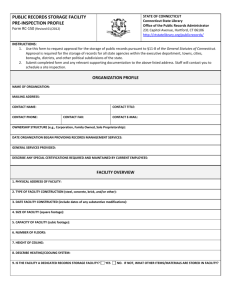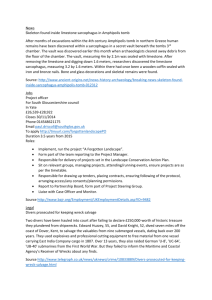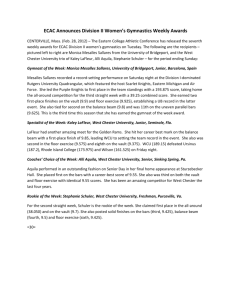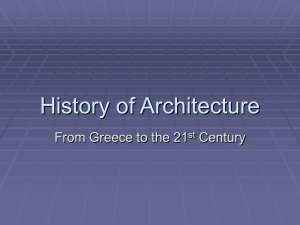Concepts of the Health Data Vault
advertisement
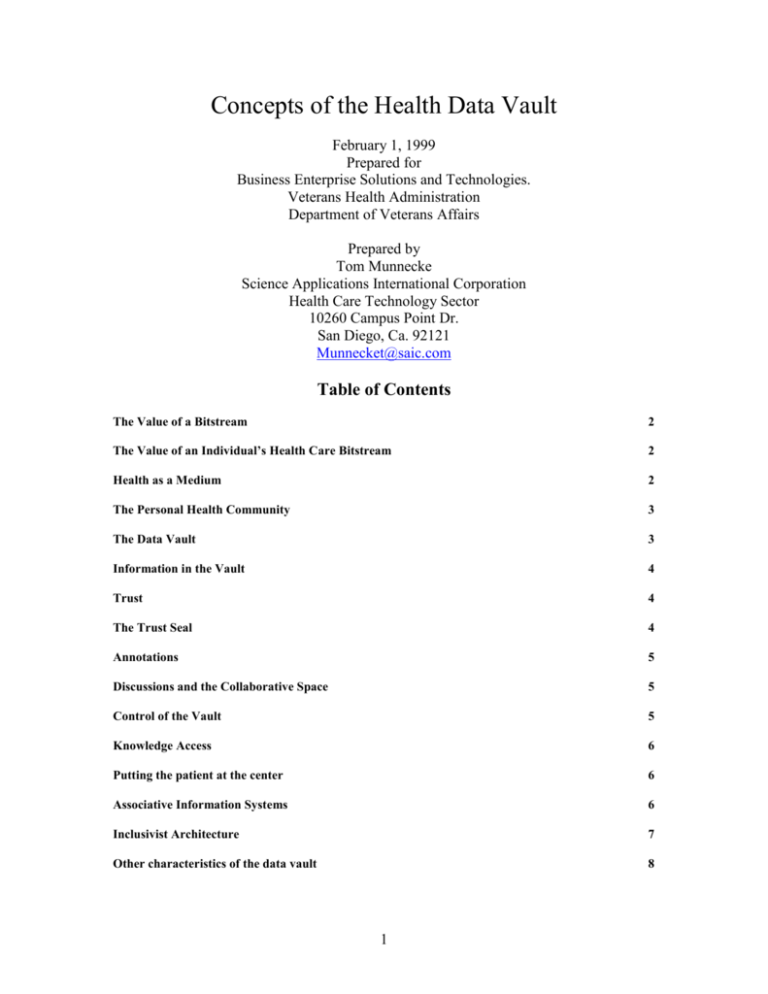
Concepts of the Health Data Vault February 1, 1999 Prepared for Business Enterprise Solutions and Technologies. Veterans Health Administration Department of Veterans Affairs Prepared by Tom Munnecke Science Applications International Corporation Health Care Technology Sector 10260 Campus Point Dr. San Diego, Ca. 92121 Munnecket@saic.com Table of Contents The Value of a Bitstream 2 The Value of an Individual’s Health Care Bitstream 2 Health as a Medium 2 The Personal Health Community 3 The Data Vault 3 Information in the Vault 4 Trust 4 The Trust Seal 4 Annotations 5 Discussions and the Collaborative Space 5 Control of the Vault 5 Knowledge Access 6 Putting the patient at the center 6 Associative Information Systems 6 Inclusivist Architecture 7 Other characteristics of the data vault 8 1 The Value of a Bitstream If we look at the history of the richest people over the past millenium, we find that during the first half, the richest people were those who were able to pillage and plunder their neighbors most effectively - Ghengis Khan was a good example. One person got richer at the expense of another losing. Towards the middle of the millenium and the industrial revolution, factories, production, and capital became sources of wealth; it was possible for a whole society to get wealthier. The richest people owned natural resources, railroads, and factories - John D. Rockefeller is an example. At the close of the millenium, the richest person's wealth is based on a bitstream of information. Microsoft's ability to organize and communicate a flow of bits to customers is now valued at $350 billion. Netscape, AOL, Yahoo!, and a host of other Internet related companies have risen to immense values based on their ability to organize and communicate bits of information. Unlike plunder or physical products, bits can be replicated almost for free. There is no central supply of bits from which manufacturers must draw when they create software. The value from a bitstream comes from its organization. Bits have to be assembled together in the proper sequence in order for them to have value. The proper sequence is a function of context, bits intended for the operating system of an Apple Computer will not work in the context of a PC or a Commodore 64. The bitstream is has value when it is communicated; bits sitting on Microsoft development machines do not have value until they are communicated to customers. The Internet has connected modern society in ways unimaginable in the past. Nathan Rothschild developed an advanced system of riders, ships, and carrier pigeons. In 1815, he was the first to hear the results of Waterloo in London, and made a fortune based on this information. Today, the general public sees CNN broadcast cruise missiles live from Baghdad within milliseconds. The "float" of information and value has diminished to nearly zero. In the past, the value of these bitstreams has been appreciated by companies and enterprises, who made it their business. Credit agencies, advertisers, medical information data bases, and others have profited from this value. The individual was largely at the mercy of others to provide it. The Value of an Individual’s Health Care Bitstream This paper addresses the bitstream of information about an individual's health. The value of this bitstream is based on its organization and communication within an individual's context. This value is not necessarily reflected in specific dollars and cents savings, but rather in the individual's health, trust in the healthcare system, and community. It has the potential to radically shift the balance of power in today’s health care system. Health as a Medium Computer visionary Alan Kay asks: 2 “What does a medium ask you to become in order to use it?” In the case of print, the answer is a rational creature. For television, a passive observer. For the telephone, a conversationalist.1 We are discussing a new medium. It asks those who use it to become collaborators in the health of an individual. In contrast to the enterprise-centric medical record, it is a private, patient-controlled collaborative space, linking information from a variety of sources. The vault is under the control of the individual, not an enterprise. The communication is private, secure, and trustworthy, and operates under the strictest principles of confidentiality. The Personal Health Community The Personal Health Community (PHC) represents a convergence of many technologies and concepts surrounding the future of health care in the age of the Internet: 1. 2. 3. 4. 5. The personal data vault. Virtual communities On Line support groups Patient centered care The view of health care as a collaborative process. The Data Vault The data vault is a secure, patient focused and controlled area in cyberspace which manages an individual’s health information, collaboration, and knowledge access. Information in the vault is separated into zones, each of which has its own set of access rules and security policies. Each zone has a community of interest, which is the set of individuals and organizations that have access to the information in the zone. Access to the zone is under the control of the individual who sets the policy and who can also see an audit trail of who has accessed information in the zone. This concept presents an alternative to the national health care identifier. Just as the banking industry is able to perform efficiently without a national credit card identifier, it is able to enhance health care without resorting to national health identifier. Instead of the enterprise centric, “health by aggregation” thinking which threatens to destroy the patient/provider trust relationship, it creates a patient focused, individualized environment which restores and enhances trust, confidentiality, and the collaborative power of computers and communications. The medical record as we see it today is an artifact of the enterprise, dedicated to enterprise’s point of view. Much of its role is as a legal justification of actions – a defensive document, protecting the provider from malpractice suits. It is as if a malpractice lawyer is peering over the shoulder of a physician every time anything is said. The data vault, given the appropriate legislative support, could restore the confidentiality and privacy which is necessary for effective health care. 1 Quoted in Schrage, Michael, No More Teams, Doubleday, 1995, p. 24. 3 Information in the Vault Information in the vault can be stored in several ways: 1. Stored as pointers to other information. For example, they may be URLs to sites which have done MRI scans. When viewers wish to view the MRI, they must access it through the data vault. The source institution (the hospital which did the MRI, for example) will only release the information to those authorized by the vault. The vault thus acts as a proxy and mediator for viewers to the patient information. 2. Copies of information from other sites. In this case, information from source sites are physically copied into the vault. Viewers retrieve this information directly from the vault. For example, the individual may have copies of their eyeglass prescriptions copied from their opthamologist to their vault. 3. Information which is recorded and managed internally to the vault. Individuals may wish to record and maintain information specific to their vault. For example, they may wish to record their weight and fitness center activities for private purposes. 4. Collaboration and annotation. The communications of the community of interest for a given zone are recorded and made part of the vault with the same levels of trust as other objects. 5. Knowledge associations. Objects from the vault are linked with other sources of medical knowledge, such as data bases, literature, on line support groups, and the like. 6. Agents. Software agents may be programmed to take actions and make associations, independent of specific actions by humans. Trust Trust is critical to the acceptance of the data vault. Individuals must feel that they can provide information to their healthcare providers, as part of a trusted community of interest. This information will not be leaked out or distributed to others without their knowledge. They create and monitor their community of interest, and are in control of access to their information. They are able to see who has referenced their information, and those who view an individual’s information need to know that their viewing is being recorded. For example, an individual may wish to allow their local pharmacist access to their active medication list. They present their membership card to the pharmacist, enter their PIN, and authorize the pharmacist to view their “active medication zone.” They may also authorize their opthamologist, chiropracter, and dentist to view this zone. Their family counseling zone, however, may be authorized only to select family members, a counselor, and their priest. The Trust Seal The trust seal is a mechanism for the vault owners and viewers to view and discover metadata about information contained within the vault. Pages of information presented by the vault have a icon which, if clicked, provides additional information about the page, its sources, date/time of entry into the vault, nomenclatures used, agents responsible, etc. The seal thus extends the web of trust around the information contained within the vault. 4 Thus, an individual can always question the authority and source of any information presented from the vault. Annotations Users may annotate information contained in the vault. This may appear as “sticky notes” attached to the objects when presented. However, they are logically associated with the vault objects, and only in the appropriate context of the community of interest and the zone in which the information is located. For example, someone may add a “sticky note” to a pulmonary function test report, saying that they had a cold just previous to the test. Discussions and the Collaborative Space A specialized form of an annotation is the discussion. In this case, the annotation becomes a thread of comments, which can be read in sequence. The properties of a discussion are: 1. Each response is attached to previous responses 2. Responses are viewable only within the selected community of interest. This may be the entire zone’s community, or a subset. 3. Readers can discover who has seen which portions of the discussion, and when they last read the discussion. 4. Responses may have links to other objects and response chains. However, messages are not necessarily stored in baskets; they can “float” over any other object in the vault. The discussion object allows the vault to become a collaborative space, providing a common area in which confidential and trusted communications may take place. This communication is carried on within the context of the zone, supporting the notion that health care is a collaborative process. The goal is to create a long-term trusted relationship between the individual and their community of interest. These objects may be channelized, that is, sorted into channels of information which can be viewed according to the viewer’s discretion. Channels allow viewers to create “what’s new” views of information, as well as focus on specific trigger events about which they want to be notified. Control of the Vault The vault policy is a set of controls which can be set by the owner. By default, each individual will have a specific set of zones, which may be used for standard information such as emergency information. Others will be set by legislation, such as HIPAA. This concept provides a concrete infrastructure from which to establish these access policies, without resorting to politically senstive issues such as the national health ID. People would name their data vault when they need health care services. Those who have a need to know information would have their requests mediated by the individual’s vault policy; their access would be recorded. Individuals who wished to sell their information to information aggregators could do so. Those who benefited from using the aggregated information would thus pay those whose information is being provided. 5 Those who wished to participate in medical research would provide their information as a policy preference. Knowledge Access The vault provides a patient-specific context, within which patient-specific knowledge may be manipulated. This is a major conceptual shift from the aggregative view of the medical record from the point of view of the health care enterprise. We are seeing the consequences of the aggregative approach today, as women’s cardiac problems are now being considered within the context of women, rather than just the aggregation represented by male research aggregations. For example, an enterprise may have a single byte field for patient sex, and it may be an F, M, or U. However, if a patient has gone through (or is going through) a sex change operation, what is the appropriate code? The patient’s vault may have an entire zone dedicated to this information. The various tests, operations, stages, counseling, lifestyle changes, etc. would all be recorded and viewable according to the zone’s policies. For those decisions in which the history of the sex of the patient is critical, this can be retreived and used in the context of that problem and that patient. Putting the patient at the center This system places each individual at the center of their own health care universe. Dr. Lawrence Weed expresses the importance of this view in our health care system: “We must consider the whole information system and not just infinitely elaborate on the parts that interest us or fit into a given specialty. Patients do not specialize, and they or their families are in charge of all the relevant variables 24 hours a day, every day. They must be given the right tools to work with. They are the most neglected source of better quality and savings in the health care system. After all: They are highly motivated, and if they are not, nothing works in the long run anyway. They do not charge. They even pay to help. There is at least one “caregiver” for every member of the population.”2 Associative Information Systems One of the mantras of modern information system is that the system needs to be “integrated.” This begs the question, “from whose perspective will the system be integrated.” Will it be integrated into a department, hospital, region, national, or personal database? Any time a system is “integrated,” there is an implicit point of view, a hierarchy from which the system is decomposed into elements and then put back 2 Weed, Lawrence, Knowledge Coupling, New Premises and New Tools for Medical Care and Education, Springer Verlag,1991, p. 13 6 together. However, systems which are integrated from one point of view become “disintegrated” from another. A medical record system integrated from a hospital’s perspective may be unintelligible from a patient’s perspective, for example. Integrated systems are based on hierarchical decomposition, tightly coupled elements, and command and control management of the data, all based on the point of view of the system. The system is built around the notion of association. Associated systems are based on web-like relationships which may be unique in every context. There is no single point of view, or “top” from which to perform a top-down analysis of the system. Elements within the system are largely autonomous, and they are loosely coupled. Dr. Weed speaks of association in medical knowledge systems: “Effective coupling of medical knowledge can be greatly facilitated by simple associative mechanisms…The notion that a simple associative mechanism can actually address the problems outlined will seem heretical to many people. Medical decisionmaking is normally seen as a complex, irregularly structured, iterative process. This view provided an early inspiration for the development of expert systems.”3 The World Wide Web is built on the notion of association. There is no WWW data base administrator to “integrate” all information on the web, nor is there a “top” from which to do a top-down analysis of what information is on the web. No one is in control of the web; each web site acts as an autonomous entity, hoping to solicit attention. The inventors of the web did not assign site numbers 1-100,000 for physics, 100,001 to 200,000 to chemistry, etc. so that the web could be “orderly.” Despite the loosely coupled, somewhat chaotic nature of the web’s content, search engines, portals, and agents have emerged to provide order – an emergent property of the system, not something that is built in by the initial designers. Inclusivist Architecture The system is not locked in to any specific health care model; architects would call this an inclusivist design. The vault must serve many points of view: “Up until now, patients have been left on their own to negotiate and relate to the arbitrarily marked off territories of holistic health, family practice, specialties of all types, Oriental medicine, Western scientific medicine, public health medicine, and osteopathic, chiropractic, allopathic medicine – to say nothing of the turfs and territorial imperatives of physicians, nurses, social workers, psychologists, paramedical personnel, medical technicians, and administrators in ever-increasing numbers.”4 3 4 ibid, p. xvii Weed, p 23. 7 No two individual’s health processes are the same, neither will be their data vaults. Each will have an individualized, personal space tailored to those with whom they chose to share their health care process. Today, the Internet is seen as something independent of “normal” medical care, as if the two were mutually incompatible. For example, the Consumer Health information Preference Survey of California Internet Users taken by the National Health Foundation (http://www.nationalhealthfdt.org/What_s_New/Survey/survey.html) reports: Over half (56%) of Californians with Internet access report seeking health information during the past year (37% of them through the Internet). Among those who seek health information, 36% report that physicians and healthcare providers are the easiest sources to use, 15% report the Internet is the easiest to use and 12% report special health and medicine advice books are easiest to use. Combining the easiest and second easiest sources to use shows a similar pattern. Physicians and healthcare providers are the easiest to use (55%) and the Internet (24%) remains the second easiest. Those with annual incomes under $50,000 are less likely (4%) than the other groups (18% for $50,000-$100,000 and 17% for over $100,000) to find special health and medical advice books easiest to use; they are more likely (14%) than other income groups (5% and 3% respectively) to find family members the easiest sources for health information. If we look at health care as a medium, the Internet becomes just another way of communicating. If a doctor communicates with a patient via a phone call, we do not distinguish it as “telephone-mediated medicine.” Similarly, communication facilitated by the Internet will in the future become the norm. Other characteristics of the data vault The vault metaphor provides a concrete way of understanding many issues relating to patient privacy, ownership of medical information, and a myriad of other issues relating to health care in the age of the Internet. The concept of a personal health community is a much broader issue than just a data vault. Whereas the medical record is a transcript of specific activities, orders, and findings, the personal health community may deal with discussions with individuals or support groups, knowledge bases, personal journals, etc, all of which affect the individual’s health. Individuals may wish to protect their association with these other groups from public viewing, in the same way that they may wish to protect specific zones of medical information. Some thoughts on vaults, derived from an email message from Dan Maloney: Health eVAult is secure storage (using encryption for storage, public/private keys to control access, keys for digital signatures, encryption of transmitted data). Policies will need to be constructed, such as “no content can be modified after it is submitted” 8 It can be deleted or added to, but not modified. This is similar to the existing situation where the patient goes to the doctor and tells them about the health events they choose to disclose (“deleting” other events from the conversation). The physician can then obtain reports from other providers about those events they know about. “entries must be digitally signed by the submitter” - ensures content integrity and identification of source Health eVet uses intelligent software agents to review the data stored in the vault to obtain recommendations, e.g. cardiac risk analysis. A Vet can order various bots to review his/her data. Health eVAult has an access policy enforcement module. This will determine who has access to the data in that individual vault and who can grant access to others. In all cases, the owner shall be able to grant access to an individual, to a portion of the vault, for a limited amount of time. Joe Veteran could give read access to a portion of his vault to a consulting physician for the next 2 hours (days/weeks/months/years) Joe Veteran can give update access to a contract provider for a period of time to post the summary of a medical procedure. Now what kind of access policies will we have. There are many that are possible, but we will have a few “standard” profiles that we would recommend. The two major categories are Ownership and Access Joint ownership: Either the sponsoring organization or the patient has control over access to the Vault Patient ownership: The patient owns the data and controls access. They may grant or revoke access by anyone including the sponsoring organization Ownership is independent of the source of the data. If you give me a paper copy of a medical procedure, I have no obligation to store it and give it back to you if you request a copy back. Access for Public Good: vault parameters can be set to give access to non patient specific data by identified software robots performing work for the public good. These robots will require digitally signed software modules coming from organizations approved by the owner, i.e. HHS Health Statistics R&D or World Health. Access for money: Vault parameters can be set to give access to non patient specific data by identified software robots that will pay for that access. Should orders even be considered as a part of Health e-vet? Well, sure. An order can be posted to the Vault, perhaps an order to specialist for a specialty consult (radiology, cardiology, or mental health). Access to that order can be to the consulting specialist during or before the scheduled appointment. Standards to be used: Published APIs Web Based, HTML, XML, PKI Defined “plug and play” transactions defined in an extensible environment Probably use HL-7 Must have timed access granting technique 9 Must audit who, when and what Use PKI for access control, digital signature and encryption 10
